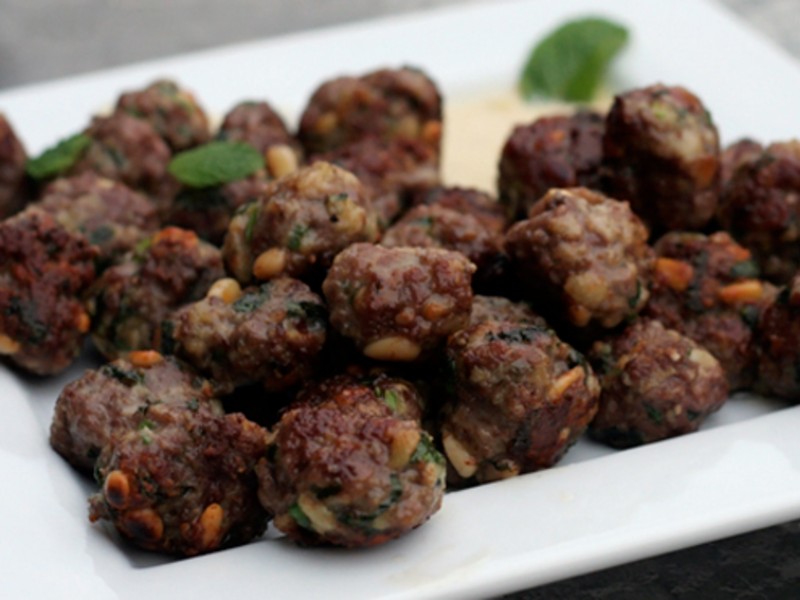Shabbat Shalom! Earlier this winter, I attended a very interesting food experience hosted by Technion Canada, the national organization that raises support and awareness for Technion-Israel Institute of Technology.
Technion Canada held Culinary Discoveries on Jan. 30, an evening focused on the science of food preparation to highlight the scientific advances that Technion students and professors have been making in the areas of food technology and food sustainability.
Technion students have produced honey that does not require bees, while Aleph Farms (its chief scientific office is a Technion professor) has been making gains in producing meat grown in the lab.
With the evening’s focus on technology, F & B Kosher, the caterer, devised a menu to highlight the science of caramelization, fermentation, spherification, sous-vide, foaming and flash freezing.
Rock the Shtetl, the popular klezmer band, played as the 130 people in attendance schmoozed and fressed on hors d’oeuvres like rice wraps, Ahi tuna tacos and beef sliders.
People were then divided into groups and ushered to various interactive stations in a huge industrial kitchen space. Here they watched the food demos and ate the particular course that each chef was showcasing, and then they changed stations. To top off the evening, people ended their meal at the nitro ice cream and nitro popcorn bar.

Elysa Greisman, national executive director of Technion Canada, said the rib eye steak was a big hit. The beef had been prepared by the sous vide method and finished by searing.

A thick steak, chicken or roast is often seared first to enhance the flavour by creating the Maillard reaction, the browning or caramelization of the outer layer of the protein. The item then goes into the oven to cook through.
However, with the sous-vide cooking method, the food is placed in a plastic pouch or a glass jar and cooked in a water bath at a low temperature so that the inside of item cooks through without overcooking the outside. The item can be seared afterward like the rib-eye steak served at the Technion gala.
Instead of a sous-vide dish, I have found a recipe that incorporates the Maillard reaction – Shannon Sarna’s recipe for Harissa Lamb Meatballs. This reaction is created because the meatballs are fried before they cook in the sauce. This recipe is from the online kosher magazine, The Nosher: https://www.myjewishlearning.com/the-nosher/harissa-lamb-meatballs-recipe/
Another menu item at the gala was a wild mushroom-stuffed Cornish hen, which was also prepared sous-vide style and served with a lemon-thyme foam.

At a third station, a chef demonstrated the spherification technique with mango juice. Spherification is a culinary process that uses sodium alginate and calcium chloride to shape a liquid into squishy spheres that resemble fish eggs. The mango spheres were served with papardelle pasta, radish and faux crab.
Norene Gilletz’s Chilled Chicken, Red Pepper and Mango Salad from The Brain Boosting Diet: Feed Your Memory is the closest kosher recipe I could find to match the mango spheres dish.
The other recipe containing some of the sphere dish ingredients is Martha Stewart’s Mango and Radish Salad with Lime Dressing: https://www.marthastewart.com/336287/mango-and-radish-salad-with-lime-dressin
HARISSA LAMB MEATBALLS (Shannon Sarna)
For the Sauce:
15-30 ml (1-2 tbsp) olive oil
1 small onion, finely diced
2 garlic cloves
Pinch caraway seeds
30 ml (2 tbs) tomato paste
1 800 g (28-oz) can diced tomatoes
1 800 g (28-oz) can crushed tomatoes
60 ml (3 heaping tbsp) of harissa paste, (you can add more to your taste)
375 ml (1½ cups) of water
2 ml (½ tsp) salt
1/4 tsp black pepper
For the Meatballs:
1.8 K (2 lbs) ground lamb
45 ml (3 tbsp) minced mint
45 ml (3 tbsp) minced flat leaf parsley
2 garlic cloves, minced
2 large eggs
5 ml (1 tsp) salt
5 ml (1 tsp) fresh lemon zest
vegetable oil for frying
To make the sauce: Heat the olive oil in a large pot over medium high heat. Saute the onion until translucent and soft, around 6-8 minutes. Add the garlic, caraway seeds and tomato paste, and saute another 2 minutes.
Add the canned tomatoes, harissa and water, and bring to a low simmer. Cook for 30-40 minutes, covered over low heat. The tomato sauce will be done when the tomatoes have broken down and the sauce has reduced slightly and is a deep colour.
To make the meatballs: Combine the ground lamb, mint, parsley, garlic, eggs, salt and lemon zest in a large bowl. Using your hands, combine until mixed throughout, but take care not to overwork the meat.
Form tablespoon-sized meatballs, using your hands or a cookie scoop. Roll them gently and place on a plate until you’re ready to fry.
Heat vegetable oil (or other neutral oil) over medium heat in a large saute pan. Fry the meatballs in batches until they are browned, rotating them to ensure they have been browned on all sides.
Remove them from the pan. You may need to add a little more oil between batches.
Add the lamb meatballs to the sauce (as well as additional liquid from frying) and allow the meat balls and sauce to simmer another 15 minutes.
Serve with couscous and chopped fresh herbs if desired.
READ: HUNDREDS OF PEOPLE SHARE MEMORIES OF A CULINARY ICON
GRILED CHICKEN, RED PEPPER AND MANGO SALAD (Norene Gilletz)
Double-Duty Vinaigrette/ Marinade
45 ml (3 tbsp) balsamic or rice vinegar
30 m (2 tbsp) extra virgin olive oil
5 ml (1 tsp) toasted sesame oil (omit for Passover)
30 ml (2 tbsp orange juice)
15 ml (1 tbsp) honey or maple syrup
2 cloves garlic (about 2 tsp/10 ml minced)
Salt and freshly ground black pepper to taste
Chicken
6 boneless, skinless single chicken breasts
Garlic powder, onion powder, pepper, and basil to taste
Salad
1.5 L (6 cups) mixed salad greens
1 firm ripe mango, peeled and sliced
1 red or yellow bell pepper, thinly sliced
1 medium red onion, halved and thinly sliced
1 medium carrot, grated
12 grape tomatoes, halved
Double-DutyVinaigrette/Marinade: In a jar, combine the vinegar, olive and sesame oils, juice, syrup, garlic and salt and pepper to taste. Cover the jar tightly and shake well. Store in the refrigerator until ready to use. Shake well before using.
Chicken: Season chicken breasts lightly on both sides.
Preheat the barbecue or grill. Grill the chicken 4–6 minutes per side, depending on the thickness. The chicken is done if it springs back when lightly touched. Once cooled, cover and refrigerate.
Salad: Wash the salad greens and dry thoroughly. Place the greens on individual dinner plates. Top with the mango, bell pepper, onion, carrot, and tomatoes. (If preparing the salad in advance, cover and refrigerate until serving time.)
Slice the chicken into long, narrow strips and arrange in an attractive design on top of the salad. Drizzle with dressing and serve.
MANGO AND RADISH SALAD WITH LIME DRESSING (Martha Stewart)
1 mango, peeled and cut into wedges
½ English cucumber, thinly sliced
1 bunch radishes (about 8), halved or quartered
15 ml (1 tbsp )finely grated lime zest
30 ml (2 tbsp) lime juice (from 2 limes)
30 ml (2 tbsp) extra-virgin olive oil
15 ml (1 tbsp) honey
Coarse salt
Arrange the mango, cucumber, and radishes on a platter.
Whisk together the lime zest and juice, oil, and honey. Season with salt.
Drizzle the dressing over salad, and season with salt.
Makes 4 servings.








